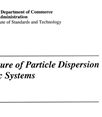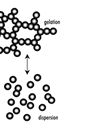
Chemistry International
Vol. 22, No.4, July 2000
2000, Vol. 22
No. 4 (July)
..Chemistry in Argentina
..News from IUPAC
..Report of Accounts 1998-99
..Reports from Symposia
..Reports from Commissions
..Provisional Recommendations
..Awards and Prizes
..New Books
..Conference Announcements
..Conference Calendar
Download the July
issue in pdf format.
(544K)
Chemistry International
Vol. 22, No. 4
July 2000New Books and Publications
New Publication from the National Institute of Standards and Technology
Guide to the Nomenclature of Particle Dispersion Technology for Ceramic Systems.
By Vincent A. Hackley. NIST Special Publication 945, U.S. Department of Commerce, Technology Administration, National Institute of Standards and Technology, 24 pp., 2000. Available from the Superintendent of Documents, U.S. Government Printing Office, Washington, DC 20402-9325.
This little pamphlet is the work of a committee of academic, government, and industry specialists and is designed to provide a collection of standard definitions for the most common technical terms used in the area of particle dispersion technology for ceramic systems. The aim is certainly a worthy one, because the fields of particle technology and colloid science cover a diverse range of applications and have given rise to an equally diverse nomenclature.
The nomenclature problem stems partly from the wide range of areas to which the subject has some relevance—from food science through pharmaceuticals and cosmetics all the way to agricultural and soil engineering. But there is also the fact that many of these areas have a very long history of prescientific technological development, and in none of them is that more evident than in ceramics. The modern scientific understanding of ceramic processing has been grafted onto the enormously rich legacy of art and craft that underpinned the technology until relatively recently, and which still strongly influences some areas even today.
Because I had an opportunity to look at the material and offer comments prior to publication, I have not found any obvious deficiencies in the final work. There are some odd statements, however, such as the separation of the term fine from coarse, which is said to correspond to a dimension less or more than roughly 37 mm (my emphasis). It seems curious to make the separation so precisely and call it roughly until one translates that dimension into a sieve size and then recognizes it in terms of an aperture for a standard screen measured in the old f.p.s. unit of inches. Such are the strange ways in which we are reminded of the history of the subject.
There are well over a hundred definitions, covering the description of disperse systems, states of subdivision, association and dissociation processes, dispersion stability, and interfacial and electrokinetic properties. Each is succinct and carefully presented together with a bibliography and index.
I would not pretend that everyone will agree that every definition is couched in the most effective way. There will even be arguments about the exact meaning of some terms. When the phenomenon of particle association is described by terms like aggregation, agglomeration, coagulation, and flocculation (and there may be more), there is ample room for disagreement on details, but the definitions offered here have the weight of common usage behind them. The purpose of the exercise is to encourage a wider and more consistent use of the terms. That can only be an aid to communication and a contribution to clarity. The distinguished group of advisors on this project and the recorder, Vince Hackley, are to be congratulated on so ably performing such an important service.
Robert J. Hunter
School of Chemistry University of Sydney
News
and Notices - Organizations and People
- Standing Committees
Divisions
- Projects - Reports
- Publications - Symposia
- AMP - Links
Page last modified 19 June 2000.
Copyright © 1997-2000 International Union of Pure and Applied Chemistry.
Questions or comments about IUPAC, please
contact the Secretariat.
Questions regarding the website, please contact [email protected]




